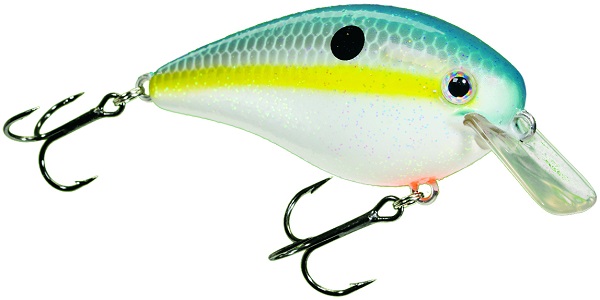 The square bill crankbait is a very early design of a crankbait. It has survived through decades and is the favorite style bait for those anglers that love to crank. The recent popularity of this bait can be linked to recent high profiles tournament wins such as the Bassmaster Classic. This style of crankbait has several important characteristics. The body is usually round and thick. It has a bill that protrudes from the chin of the bait. The angle of the bill will dictate the amount of wobble. These two characteristics lend a distinctive vibration to this bait. The amount of water that is moved by a square bill crankbait makes it a fantastic choice in stained to muddy water. The overall package is very weedless. This allows the angler the opportunity to cast it in and around heavy cover.
The square bill crankbait is a very early design of a crankbait. It has survived through decades and is the favorite style bait for those anglers that love to crank. The recent popularity of this bait can be linked to recent high profiles tournament wins such as the Bassmaster Classic. This style of crankbait has several important characteristics. The body is usually round and thick. It has a bill that protrudes from the chin of the bait. The angle of the bill will dictate the amount of wobble. These two characteristics lend a distinctive vibration to this bait. The amount of water that is moved by a square bill crankbait makes it a fantastic choice in stained to muddy water. The overall package is very weedless. This allows the angler the opportunity to cast it in and around heavy cover.
The original square bill crankbaits were wooden works of art. These baits are still made by craftsmen working with wood today. There is a certain romance to these baits with bass fishermen. All crankbaits that are made of wood are like people. No two baits are alike. They have a finite amount of casts per lure. If a “special” lure is found, it must be guarded from abuse to make it last. Technology has made the wooden bait a virtual thing of the past. Manufacturers now have the ability to make near perfect clones in every unit. The plastic square bills have the very same actions as their wooden cousins. They are also much more durable than the wooden versions. Meaning the angler can get very aggressive with presentations around cover.

I like six to seven foot rods with light tips when cranking. Using 15 to 25-pound line also allows you to do things you can’t do with lighter line. Try a fluorocarbon for its abrasion resistance and better deflections. B.A.S.S. photo.
Largemouth bass are ambush predators. They tend to hide and attack their food as it passes them by in hiding. This makes the bass vulnerable to square bill bait cast to cover. The most important trait the square bill possesses is its ability to defect or bounce off of cover. It is at that instant the bass will strike. A common mistake made by most anglers is not making enough casts to an individual piece of cover. By repetitive casting, this gives the bass a chance to be drawn to the bait from within the cover. Changing the angle of the cast to an object can pay huge dividends. Always make an additional cast to a piece of cover after catching a fish. Bass are social creatures. They like to hang around with other fish. If the angler will condition their mind to make an additional cast after catch a fish on the square bill, many unexpected bass will be caught behind the first fish.
Tackle selection is very important when fishing square bill baits. Six to seven foot rods with light tips are needed to make the appropriate presentations. The rod will need to have strong backbone to lead the fish from the cover once hooked. Glass rods like a Power Tackle Crankbait rod are great choices. A glass rod will allow the fish the ability to engulf the bait before the angler feels the strike. Fiberglass does not transmit the strike as fast as graphite. The angler will not feel the strike for a fraction of a second later allowing the bass to be hooked better.
Heavy line is needed with this technique. Line test of 15lb -25lb is the standard. The square bill can be made to do certain things with larger line sizes. The heavy line has a larger diameter. This will create drag as the lure is retrieved. This will restrict the depth of the crankbait. Thinner lines of smaller diameter will allow the bait to seek deeper depths. Fluorocarbon line is a great choice due to its abrasion resistance. It will also make for better deflections.
Bait casting reels are the standard when using a square bill crankbait. A Lew’s Speed Spool in a 6.4:1 retrieve is the perfect style of reel. Accuracy is of the utmost importance when utilizing the square bill crankbait around heavy cover.
Color choices are very simple when shallow cranking. Allow the most prevent food source dictate color. White sided baits like Strike King’s “Sexy Shad” color are very similar to the color of a shad. Chartreuse with a back black is a proven color in stained water conditions. This color mimics a bluegill. This is the color that captured the 2011 Bassmaster Classic. Kevin Vandam cranked a Strike King KVD 1.5 crankbait around stumps to “deflect” his way to the title.
Cranking a square bill crankbait is a very productive and straight forward technique. Follow these guidelines to crank heavy cover bass to your boat.
